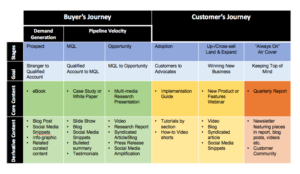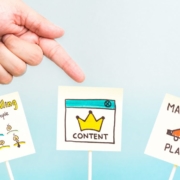Feed the Content Beast: Scale with Derivative Content
To ‘Feed the Content Beast’ seems to be a constant struggle for B2B marketers and businesses selling high consideration products/services and oftentimes a lengthy buying cycle.
Yet it’s essential to educate and enable prospects to self-sell at their own pace. Moreover firms, with content resources and associated campaigns enabled by an integrated technology stack, can capture, track and nurture those interested prospects to marketing qualified or sales accepted leads and hand off to sales for 1:1 selling. The rub: quality content assets and tools are required throughout the buyer journey as well as the customer journey and building a comprehensive content program can be daunting.
Scaling Content Marketing
Quality premium content comes at a price. Thus, devising a plan and strategy to extend the life of your investment becomes essential to feed the content beast.
A solution is to take nuggets of information gleaned from the premium content asset development process and transform them into different formats and for different channels. Notwithstanding each piece should be tailored to the channel and directly related to the premium asset, you may also be able to split the premium content into parts. An important webinar or virtual event can be transformed into short podcasts or video pieces, as well as a comprehensive PowerPoint, an article or blog that can by shared/syndicated; even more, a native advertisement, short social media posts with links to register for a replay of the webinar itself, a direct mail piece and so on.
For example, if you have live quarterly webinars featuring 3 or 4 experts on a discussion topic, these can later be edited into 6 to 10 segments and an executive summary can be added.
Lifecycle Content Framework
Taking this further, content marketers and campaign architects (who may be one and the same) need to be always working towards giving their target audience/s more of what they want, how they want it, and when they want it. And in this way align with the customers’ buying cycles. See illustrative chart below.
 While you can’t possibly plan all the derivative content in advance; the more you do the better it will flow with related campaigns. Waiting can throw off the timing of a campaign that it’s tied to.
While you can’t possibly plan all the derivative content in advance; the more you do the better it will flow with related campaigns. Waiting can throw off the timing of a campaign that it’s tied to.
Over the course of publishing premium and derivative content — assuming you have tracking and automated conversion/nurturing tools — you will be able to gauge the formats, channels and subject matter that capture the most engagement, drive the most leads.
Finally, be sure to use some form of digital asset management software to catalogue, easily version and maintain repositories of photos, audio files, graphics, multimedia and video files.
In closing here is a handy checklist:
“The 5 Steps to Take for a Derivative Content Plan”:
- Define the core “premium” primary asset and theme
- Uncover the elements of the primary asset
- Develop tailored derivative content for each channel (e,g, 1 LinkedIn Post, 10 Tweets, 6 Underlying articles, segments, info-graphic, slide show)
- Develop a content publishing timeline for each derivative element
- Set it and forget it










Leave a Reply
Want to join the discussion?Feel free to contribute!